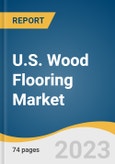The growing consumer demand for innovative buildings equipped with modern technologies and improved aesthetic appeal and energy efficiency is expected to drive the growth in the usage of wood flooring in residential establishments in the U.S. over the forecast period. Moreover, there is growth in the construction of green buildings in the country owing to the rising awareness among the masses regarding the benefits of energy-efficient buildings with improved indoor air quality. This is projected to drive sustainable building construction activities in the U.S., thereby positively impacting the demand for the product in the country owing to their low volatile organic compound (VOC) emissions.
The durability of hardwood flooring varies with the type of wood species used for developing it. Maple, hickory, and oak are among the most used hardwood species for developing flooring in the U.S. The hardness and durability of wood materials are measured according to the Janka Scale which tests the ability of a particular wood species to withstand dents and dings. The scale is determined by the amount of pound-force required to push a 0.444-inch diameter steel ball halfway into the wood.
Seasonality contributes to the variation in the prices of wood logs. Wet weather results in an inconsistent supply of timber to the manufacturing facilities, resulting in a hike in the prices of timber being supplied for use as a raw material for developing flooring. Loggers tend to shift their production units to areas falling under wet tracts during the season of heavy rainfalls and charge high prices for their timber.
Moreover, shifting of requisite equipment from one track to another is a costly process. In addition, tree quality and size are other factors that decide the prices of raw materials. Saw timber with a diameter at breast height (DBH) of 15 inches is more expensive than saw timber of 10 inches. Thus, fluctuations in raw material costs pose a challenge to the growth of the market in the U.S.
A large number of manufacturers are present at the country level. In addition, competitive imports of wood flooring from China, Brazil, and Europe present significant competition to the players in the market. The market players focus mainly on innovation regarding the development of eco-friendly, cost-effective, durable, and low-maintenance flooring solutions for a wide range of applications.
U.S. Wood Flooring Market Report Highlights
- In terms of product, the engineered wood segment dominated the market in 2022 with a revenue share of 52.9%. Over the years, engineered wood flooring has emerged as a comparatively low-cost alternative to solid wood flooring. Moreover, engineered wood is relatively less susceptible to moisture and temperature changes. These factors fuel the demand for engineered wood flooring in the U.S.
- In terms of wood type, the Red oak segment dominated the market in 2022 with a revenue share of 35.2%. This segment of the market is projected to witness significant growth over the forecast period owing to the increasing adoption of red oak for developing flooring due to its low cost, durability, and.
- In terms of application, the residential application segment led the market in 2022 with a volume share of 76.6%. Wooden flooring is widely used in residential applications owing to its durability and superior aesthetic appeal. Therefore, the flourishing housing sector in the U.S. with required regulatory support in terms of permits is expected to boost the demand for wood flooring in residential applications in the country over the forecast period
- The market is characterized by the presence of numerous established regional players, who control the larger market share. Consumers prefer manufacturers with a robust reputation in the market, thereby making it challenging for the new entrants to widen their customer base. Moreover, the high initial cost required to establish the business is expected to discourage the entry of new players. Thus, the threat of new entrants in the market is expected to be low over the forecast period
Table of Contents
Companies Mentioned
- Mohawk Industries, Inc.
- Tarkett
- Forbo Flooring North America
- Interface, Inc.
- EGGER Group
- LG Hausys, Ltd.
- Shaw Industries Group, Inc
- Mannington Mills, Inc.
- Armstrong Flooring
- Gerflor
- Polyflor Ltd.
- Porcelanosa
- Milliken & Company
- Beaulieu International Group
- Congoleum
Methodology

LOADING...
Table Information
| Report Attribute | Details |
|---|---|
| No. of Pages | 74 |
| Published | September 2023 |
| Forecast Period | 2022 - 2030 |
| Estimated Market Value ( USD | $ 5.96 Billion |
| Forecasted Market Value ( USD | $ 7.02 Billion |
| Compound Annual Growth Rate | 2.1% |
| Regions Covered | United States |
| No. of Companies Mentioned | 15 |









